Menus
- Where is the racetrack?
- The primary and secondary gear ratios have remained the same
- Better throttle response on the old Kawasaki Ninja ZX-10R
- Showa fork of the new Kawa is convincing
- Chassis probably the big plus of the new Kawasaki
- Sophisticated system of driving aids in the 2016 model
- Technical data and measured values
- Performance measurements
- Mode settings
- Conclusion
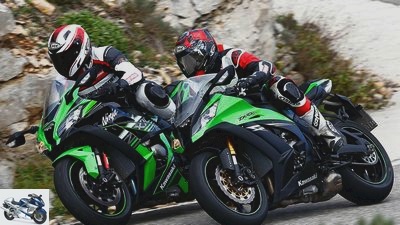
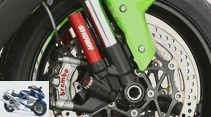
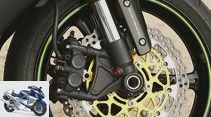
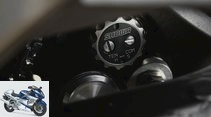
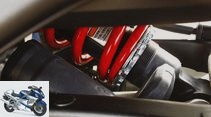
24 photos
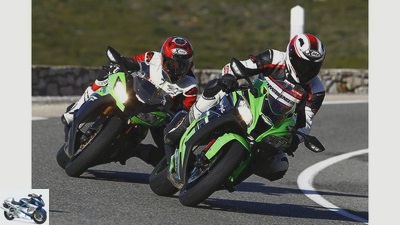
www.factstudio.de
1/24
Kawasaki ZX-10R: old versus new.
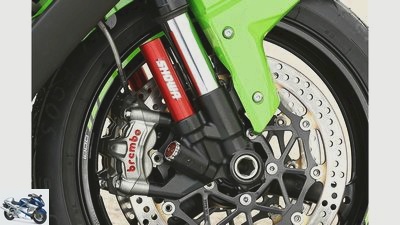
www.factstudio.de
2/24
Kawasaki ZX-10R 2016: Brembo instead of Tokico, “balance free” instead of “Big Piston”. Both changes bring progress, especially the fork. The damping is now adjusted below.
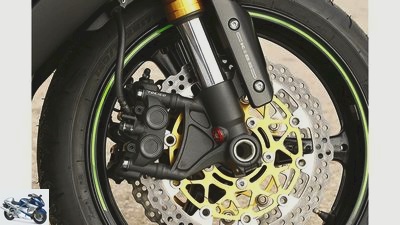
www.factstudio.de
3/24
Kawasaki ZX-10R 2015.
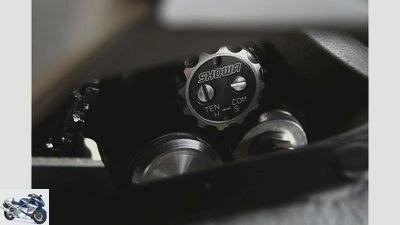
www.factstudio.de
4/24
Kawasaki ZX-10R 2016: Compact, thanks to the transverse expansion tank, the damper of the new ZX-10R has a closed cartridge. It works better too.
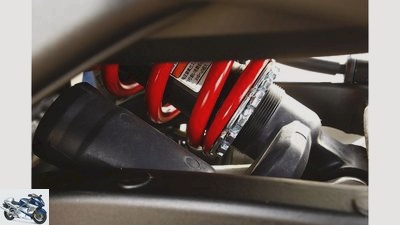
www.factstudio.de
5/24
Kawasaki ZX-10R 2015.
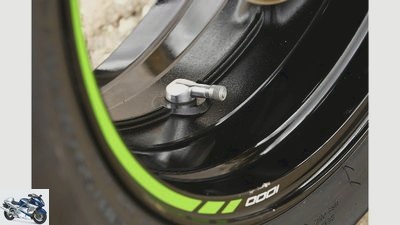
www.factstudio.de
6/24
Kawasaki ZX-10R 2016: Probably because of the 330 mm brake discs in the front wheel, Kawasaki donated cranked valves to the new sportswoman.
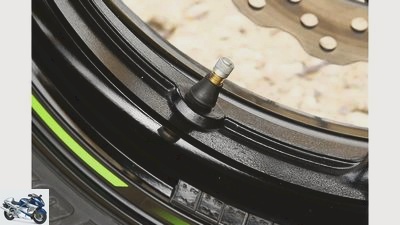
www.factstudio.de
7/24
Kawasaki ZX-10R 2015.
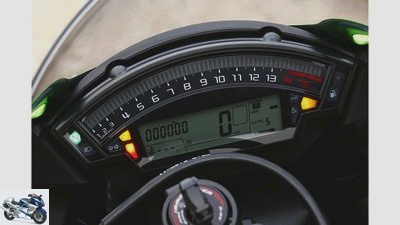
www.factstudio.de
8/24
Kawasaki ZX-10R 2016: who will find the differences? The design of the display instrument has remained almost the same, only the placement of some control lights has changed.
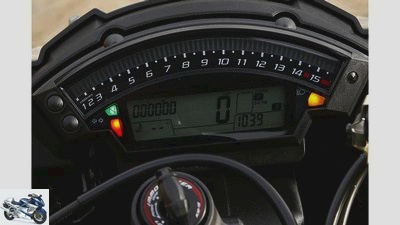
www.factstudio.de
9/24
Kawasaki ZX-10R 2015.
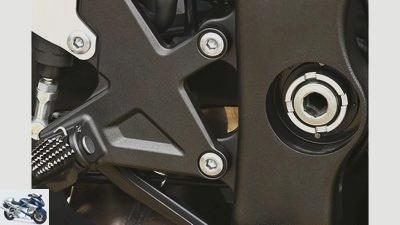
www.factstudio.de
10/24
Kawasaki ZX-10R 2016: It is worth doing without four holes and threads?…

www.factstudio.de
11/24
…Regardless, the testers switched to the low detent position on the 2015 ZX-10R anyway.

www.factstudio.de
12/24
Kawasaki ZX-10R 2015.
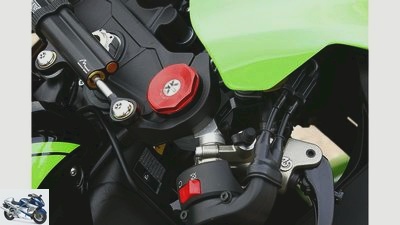
www.factstudio.de
13/24
Kawasaki ZX-10R 2016: Instead of compression and rebound, the spring preload is now set at the top. Please only with a precisely fitting screwdriver.
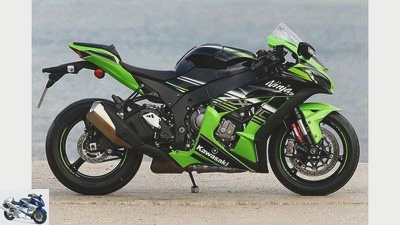
www.factstudio.de
14/24
Kawasaki ZX-10R from 2016.

www.factstudio.de
15/24
Kawasaki ZX-10R from 2015.
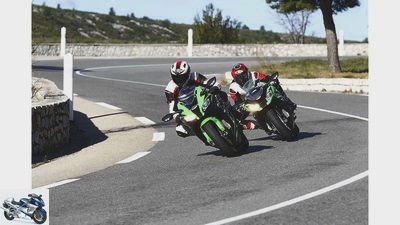
www.factstudio.de
16/24
Kawasaki ZX-10R: old versus new.
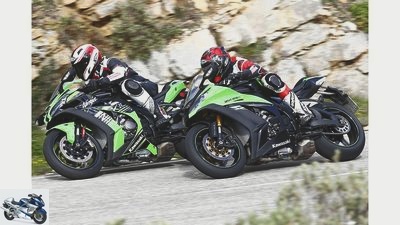
www.factstudio.de
17/24
Kawasaki ZX-10R: old versus new.
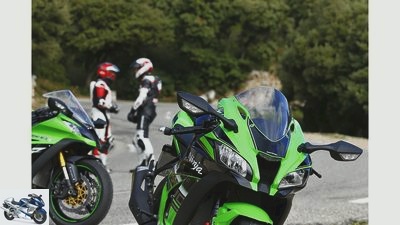
www.factstudio.de
18/24
Kawasaki ZX-10R: old versus new.
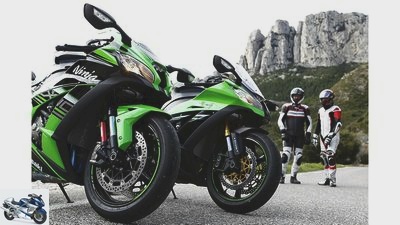
www.factstudio.de
19/24
Kawasaki ZX-10R: old versus new.
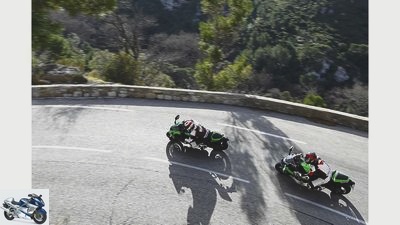
www.factstudio.de
20/24
It’s like always: cornering with super athletes requires increased effort and takes getting used to. But when you’ve shot yourself in, the sun rises – also in terms of driving dynamics.
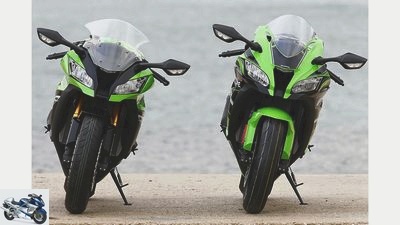
www.factstudio.de
21/24
Kawasaki ZX-10R: old versus new.
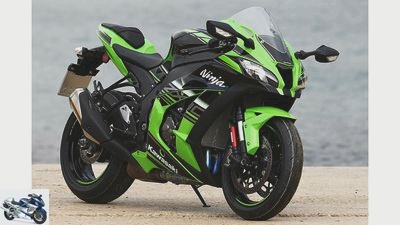
www.factstudio.de
22/24
Kawasaki ZX-10R from 2016.
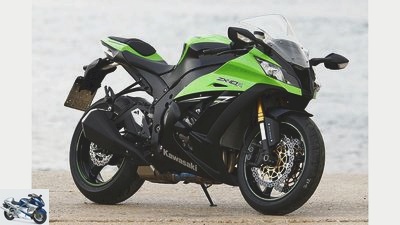
www.factstudio.de
23/24
Kawasaki ZX-10R from 2015.
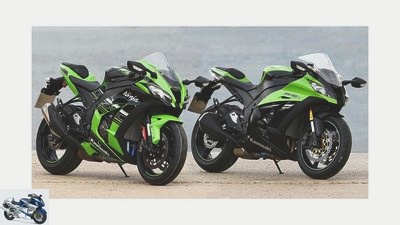
www.factstudio.de
24/24
The rear of the new one (left) rises steeply and looks more dynamic – despite the return to conventional indicators.
Kawasaki Ninja ZX-10R – old versus new compared
Where is the racetrack?
The Kawasaki Ninja ZX-10R has been an almost flawless racing machine since 2011. The successor was even more tailored to the sport. As street-legal motorcycles, the two had to do a comparison in everyday life – and really missed the race track.
The regulations of the Superbike World Championship allow little tuning, almost no modifications are allowed in the Superstock classes. Anyone who wants to be successful in races therefore needs a motorcycle that already offers the best conditions for sport in series production. This fact brings the buyers of such production racers steep prices, fascinating high-quality material and sometimes more “racing spirit” than they would like if they still want to drive on public roads. Consequently, the Kawasaki developers also maintain their racing performance Kawasaki Ninja ZX-10R in some details at the expense of everyday practicality.
This becomes clear in the gear ratio. The Kawasaki Ninja ZX-10R, which has been built since 2011, had an extra long first gear so that the following gears could be closely connected. A clear advantage on the racetrack, where you rarely drive so slowly that you slip out of the high-torque area in first gear. On the road, however, this interpretation is a nuisance, and not just in city traffic. Many a hairpin bend on MOTORRAD’s winter home routes in the south of France also pushes the four-cylinder so deep into the engine speed range that only clutch loops can help it out again.
The primary and secondary gear ratios have remained the same
This has not changed in the 2016 model of the Kawasaki Ninja ZX-10R. The primary and secondary ratios have remained the same, as has the ratio of first gear and the tire size. The performance curves hardly differ either, sometimes one is on top, sometimes the other. On the other hand, gears two to six are now even closer together, which slightly shortens the overall ratio in sixth gear.
As the comparative measurements show, this hardly helped the pulling power, because the revised engine falls significantly behind up to 8000 rpm. The acceleration values of the new Kawasaki Ninja ZX-10R are not better either, despite the narrower gears and shift assistants. The new model can only set itself apart from its predecessor when it reaches maximum performance.
Better throttle response on the old Kawasaki Ninja ZX-10R
Apparently, Kawasaki had to put in a lot of effort to train the new Euro 4 homologated machine to have the same driving dynamics as the previous model. But the consumption of the new is 0.2 liters per 100 kilometers higher, probably because of the shorter translation. When both motorcycles are ridden with high performance, the gap opens even further. The old Kawasaki Ninja ZX-10R then comes to 7.2, the new one to 7.8 liters per 100 kilometers.
Another detail in which the old Kawasaki Ninja ZX-10R offers advantages over the new is the throttle response. Precisely because the previous ZX-10R was criticized for its tough load changes. But you can still cope better with them in comparison than with the peculiarity of the new one, which only hesitantly opens the throttle valve in the middle of the curve. Often at the apex one lacks the supportive effect of acceleration for a moment; and involuntarily you turn up further than it fits the curve, in order to overcome the hesitation of ride-by-wire. The change to the “middle” mode, in which a maximum of 80 percent of the engine power is released, brought no change.
Showa fork of the new Kawa is convincing
One can get used to it. If you only drive the new Kawasaki Ninja ZX-10R for a long time, you may not be able to understand this criticism. In direct comparison, however, it becomes clear that it requires a high basic speed and often more feeling from the driver than other motorcycles in its class. The 2016 ZX-10R offers spectacular innovations in the form of its Showa fork with the distinctive red anodized reservoirs. Like the shock absorber, it is constructed on the principle of closed, gas-pressurized damper cartridges. In the test machine, this elaborate fork convinced across the board.
If you press the front while standing, it cushions so tight that you immediately want to reach for a screwdriver to open the cushioning wide. You don’t need to, because while driving it irons bumps in the road in an almost unbelievable way. The big piston fork of the old Kawasaki Ninja ZX-10R does not respond well even with the compression stage wide open; instead of sliding over the waves, it rumbles over them. The new, compact strut works much better than the old one in combination with a new leverage. It is more sensitive and offers greater reserves. On a bumpy test track, which the testers drove along at high speed, the 2016 Kawa almost always kept the wheels on the ground, while the predecessor performed the entire repertoire from jumping to punching, mainly with the hindquarters. However, neither of them knew anything about the handlebars.
www.factstudio.de
In which disciplines can the new ZX-10R set itself apart from its predecessor?
The chassis geometry of the new Kawasaki Ninja ZX-10R has largely remained the same. A longer swing arm extends the wheelbase, while the steering head, which is set back by seven millimeters, puts more weight on the front wheel. These changes and five kilograms of extra weight should actually make the machine more sluggish, but it actually turns in more easily than its predecessor and can be steered more precisely.
It owes these advantages to its series tires, Bridgestone RS 10 with special code L. The aging BT 16s of the old Kawasaki Ninja ZX-10R do not have much to order compared to modern tires.
Chassis probably the big plus of the new Kawasaki
Even if the comprehensive racetrack comparison is still pending at the time of this test, the prognosis is risky: The chassis is the big plus of the new Kawasaki Ninja ZX-10R. And although the old one with its Tokico brake calipers and 310 wave discs brakes excellently, the new one goes one better. Your Brembo system, with 330 millimeter discs, bites energetically but easily when the pads are put in. It has already proven its stability at the presentation in Sepang.
However, the ABS of the new Kawasaki Ninja ZX-10R is more sharply tuned than that of the old ones. Not only when braking hard downhill does it allow comparatively high stoppies, and the rear also lifts off more vehemently. This, too, is probably due to the pursuit of racetrack suitability. Because the ABS can only be switched off with a plug from the racing kit, the engineers did not want to reduce the braking performance of super sports tires with defensive ABS tuning.
Sophisticated system of driving aids in the 2016 model
The development work of the electronics specialists from Kawasaki and Bosch has given the new Kawasaki Ninja ZX-10R a sophisticated system of driving aids, which, of course, can hardly be exhausted in a country road test. Using the Race Start Assistant for starting traffic lights is silly, and the now five-stage traction control (three stages on the previous model) allows you to accelerate in stages three and two in an inclined position.
In the sharpest level one, long drifts are possible, but require a life-negating driving style, which one likes to do without between rock faces and abysses. And anyone who activates defensive levels four and five in the wet will be amazed at how energetically they can still accelerate out of the curve. The normal engine braking torque also works perfectly for everyday use.
www.factstudio.de
The rear of the new one (left) is steeper and looks more dynamic.
At the presentation of the new Kawasaki Ninja ZX-10R in Sepang, project manager Yoshimoto Matsuda explained that other high-quality equipment details had been dispensed with in favor of the elaborate suspension elements and braking system, if these did not directly benefit the driving dynamics. He cited the meter as an example, but this approach resulted in savings in other areas as well. The rear of the new one was designed in an old-fashioned way with conventional indicators, while the indicators of the old one are integrated into the rear fairing.
The height of the footrests on the new ZX-10R is also no longer adjustable, but rather fixed in a position that roughly corresponds to the lower footrest position on the old one. The cladding front, with an integrated pane instead of the one previously attached, also looks conventional. This choice is justified with the better wind protection, but the reason for this choice is more likely to be that the simple bubble pane of the new one is cheaper to manufacture than the elaborately shaped part of the predecessor. In terms of the design of the exhaust system, the new Kawasaki Ninja ZX-10R clearly wins, and the cranked valves in the wheels are also seen and used with pleasure. They were probably necessary because of the huge brake discs in the front wheel.
Technical data and measured values
www.factstudio.de
Kawasaki Ninja ZX-10R from 2015.
engine:
| Kawasaki Ninja ZX-10R (2015) | Kawasaki Ninja ZX-10R (2016) | |
| design type | Four-cylinder, four-stroke in-line engine | Four-cylinder, four-stroke in-line engine |
| injection | 4 x Ø 47 mm | 4 x Ø 47 mm |
| coupling | Multi-disc oil bath clutch (anti-hopping) | Multi-disc oil bath clutch (anti-hopping) |
| Bore x stroke | 76.0 x 55.0 mm | 76.0 x 55.0 mm |
| Displacement | 998 cc | 998 cc |
| compression | 13.0: 1 | 13.0: 1 |
| power | 147.0 kW (200 hp) at 13,000 rpm | 147.0 kW (200 hp) at 13,000 rpm |
| Torque | 112 Nm at 11,500 rpm | 113 Nm at 11,500 rpm |
Landing gear:
| Kawasaki Ninja ZX-10R (2015) |
Kawasaki Ninja ZX-10R (2016) | |
| frame | Bridge frame made of aluminum | Bridge frame made of aluminum |
| fork | Upside-down fork, Ø 43 mm | Upside-down fork, Ø 43 mm |
| Steering damper | electro-hydraulic | electro-hydraulic |
| Brakes front / rear | Ø 310/220 mm | Ø 330/220 mm |
| Assistance systems | ABS, traction control | ABS, traction control |
| bikes | 3.50 x 17; 6.00 x 17 | 3.50 x 17; 6.00 x 17 |
| tires | 120/70 ZR 17; 190/55 ZR 17 | 120/70 ZR 17; 190/55 ZR 17 |
| Tires | Bridgestone BT 016 “CC” | Bridgestone RS 10 “L” |
Dimensions + weight:
| Kawasaki Ninja ZX-10R (2015) |
Kawasaki Ninja ZX-10R (2016) | |
| wheelbase | 1425 mm | 1440 mm |
| Steering head angle | 65.0 degrees | 65.0 degrees |
| trailing | 107 mm | 107 mm |
| Front / rear suspension travel | 120/125 mm | 120/114 mm |
| Seat height 1 | 810 mm | 815 mm |
| Weight with full tank 1 | 203 kg | 208 kg |
| Payload 1 | 178 kg | 178 kg |
| Tank capacity / reserve | 17.0 liters | 17.0 liters |
| Service intervals | 6000 km | 6000 km |
| price | 16,695 euros | 17,195 euros |
| Additional costs | 280 euros | 280 euros |
MOTORCYCLE readings:
| Kawasaki Ninja ZX-10R (2015) |
Kawasaki Ninja ZX-10R (2016) | |
| Top speed * | 295 km / h | 298 km / h |
| acceleration | ||
| 0-100 km / h | 3.4 sec | 3.4 sec |
| 0-140 km / h | 4.7 sec | 4.7 sec |
| 0-200 km / h | 7.4 sec | 7.4 sec |
| Draft | ||
| 60-100 km / h | 4.1 sec | 4.1 sec |
| 100-140 km / h | 3.5 sec | 3.6 sec |
| 140-180 km / h | 3.7 sec | 3.6 sec |
| consumption | 5.6 liters | 5.8 liters |
| Country road / 100 km | ||
| Reach country road | 304 km | 293 km |
Performance measurements
Power on the crankshaft. Measurements on the Dynojet roller test stand 250, corrected according to 95/1 / EG, maximum possible deviation ± 5%.
The difference is small, the tendency is clear: In the lower and medium speed range up to 8400 rpm, the old Kawasaki Ninja ZX-10R is ahead, and the advantage of the new one remains low even near top performance. It will be interesting to see how other manufacturers convert their super sports bikes to Euro 4.
Mode settings
www.factstudio.de
It’s like always: cornering with super athletes requires increased effort and takes getting used to. But when you’ve shot yourself in, the sun rises – also in terms of driving dynamics.
In terms of ease of use, traction control was preferred. Both on the old Kawasaki Ninja ZX-10R and the new one, it can be adjusted while driving with a long press of the switch on the left end of the handlebar. The other functions require a descent into the “Select menu”, so more attention.
| Kawasaki Ninja ZX-10R (2015) |
Kawasaki Ninja ZX-10R (2016) | |
| engine | Mode F (full power), M (80%), L (60%) | Mode F (full power), M (80%), L (60%) |
| SECTION | cannot be switched off | can only be switched off with a special plug (racing kit) |
| Traction control | Level one (least intervention) to three (most severe intervention), can be switched off | Level one (least intervention) to five (most severe intervention), can be switched off |
| Shift assistant | – | only for upshifting, can be switched off |
| Engine braking torque control | – | Normal mode, L (reduced engine braking torque) |
| Race start assistant | – | Mode one (full acceleration, maximum 9000 / min), mode two and three (medium and lowest acceleration, maximum 8000 / min) |
Conclusion
www.factstudio.de
The new engine does not bring any progress in series production.
Euro 4 is one reason for the modifications to the engine, another is the higher tuning potential for the Superbike World Championship. In series production, however, the new engine does not bring any progress. The case is completely different with the chassis. The fork and shock absorber worked fantastically well in the test motorcycle, the series tires do a good job, the higher front wheel load and the longer swing arm should also be advantageous on the racetrack. And the brake on the new Kawasaki Ninja ZX-10R is a stunner.
Related articles
-
New Kawasaki Ninja ZX-10R (2016) in the driving report
Kawasaki 18 pictures Kawasaki 1/18 Kawasaki Ninja ZX-10R. Kawasaki 2/18 Kawasaki Ninja ZX-10R. Kawasaki 3/18 Kawasaki Ninja ZX-10R. Kawasaki 4/18 Kawasaki …
-
Kawasaki Ninja ZX-10R in the PS driving report
Kawasaki 34 pictures Kawasaki 1/34 Kawasaki ZX-10R (2016). Kawasaki 2/34 Kawasaki ZX-10R (2016). Kawasaki 3/34 Kawasaki ZX-10R (2016). Kawasaki 4/34 …
-
Kawasaki Ninja ZX-10R after-test the brake
PHOTO-BK.COM 34 pictures Kawasaki 1/34 Kawasaki ZX-10R (2016). Kawasaki 2/34 Kawasaki ZX-10R (2016). Kawasaki 3/34 Kawasaki ZX-10R (2016). Kawasaki 4/34 …
-
Kawasaki Ninja H2 in the top test
Bilski 26 pictures Bilski 1/26 Mi 218 hp, the H2 is the most powerful bike on the MOTORRAD test bench to date. Bilski 2/26 The polished stainless steel elbows form …
-
Tested BMW HP4, Kawasaki ZX-10R, MV Agusta F4 RR
Jahn 23 photos Jahn 1/23 BMW HP4 against MV Agusta F4 RR and Kawasaki ZX-10R. Jahn 2/23 MV Agusta F4 RR – lap time: 1.30.854 min (+ 0.709 sec). Jahn 3/23…
-
Kawasaki Ninja 300 and KTM RC 390 in the test
31 photos 1/31 KTM RC 390. 2/31 Comparison test Kawasaki Ninja 300 and KTM RC 390. 3/31 Comparison…
-
Kawasaki ZX-10R and BMW S 1000 RR in a comparison test
www.bilski-fotografie.de 25 pictures www.bilski-fotografie.de 1/25 Let’s first take a look at the new Kawasaki ZX-10R. www.bilski-fotografie.de …
-
Set the Kawasaki Ninja ZX-10R correctly
Kawasaki 34 pictures Kawasaki 1/34 Kawasaki ZX-10R (2016). Kawasaki 2/34 Kawasaki ZX-10R (2016). Kawasaki 3/34 Kawasaki ZX-10R (2016). Kawasaki 4/34 …
-
Top test: Kawasaki ZX-10R old-new
Top test: Kawasaki ZX-10R old / new The double top test of the old and new 10 ninja The ZX-10R has never lacked power. But now the tens…
-
Kawasaki ZXR 400 Kawasaki Ninja 400 comparison test
fact 14 pictures fact 1/14 Basically, the ZXR 400 owes its origin to the TT on the Isle of Man. fact 2/14 Kawasaki ZXR 400. fact 3/14 Because the TT-F3 …